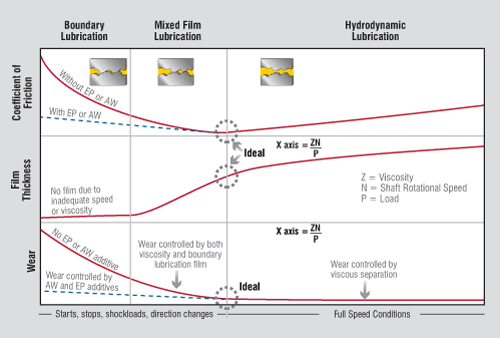Go back and learn hydrodynamics, the nature of the wedge, and the influence of boundary lubrication. There is a reason why we have EP and AW adds, and why we see a minima in wear on the Stribeck curve when we hit the point between mixed film and hydrodynamic lubrication. Within the engine the fluid velocity transitions into steady flow, any shear-induced thinning occurs, there is local heating, viscosity decreases, etc. Given the bearing size, clearances, pump flow and pressure, and so on, it seems to not be a practical issue for all intents and purposes.
It's valid to consider that oil is dynamic, especially over the OCI and conditions incurred. That's for sure. But IMO that has also been part of the consideration set in engineering and specifying a lubricant to do a job. One of the comments when people were transitioning from 5w-30 to 5w-20 oils was that the 30wt oils often sheared down into a heavy 20, so people HAVE been running lighter oils for a long time and not known it. The intent of that comment was to show that if the 5w-20 oils coming on market are shear-stable, then it is no different than what ran in most sumps for the last 1500+ miles anyway for years and years past.
UOA is no newfangled technique. Engine manufacturers and lubrication engineers know what an oil will look like after a relevant amount of shearing, heating, oxidation, etc. These are all knobs which can be turned (look at older versions of M1 0w-40 which competed shearing with oxidation to maintain a 40wt A3 oil) as part of the lube design. The engine builders know what they need to know - Viscosity, rotational speed and load. From Noria:
This stuff is easily calculated for designs and across the lifecycle of the engine and lubricant. There is sufficient variability in lube options that the "right one" can be specified or a specification can be written to make it work.
Example: is 10w-60 REALLY necessary for an M engine? Maybe really a 50wt is necessary, but given the characteristics of service interval and available lubricants, the 10w-60 was selected to provide the maximum "time at rated condition" (which is what engineering stuff is really about) to provide "design life at rated condition". That is the end game and goal. To do that, as cheaply as possible, with just enough overdesign to ensure optimal MTBF/MTBO and customer satisfaction without costing too much in NRE, parts, labor, etc.
But again, go back and check your knowledge of the Stribeck Curve. At startup and until that pressure wedge occurs in a journal bearing, you are purely talking boundary lubrication. Once you get bast the boundary phase and the flowing lube can inherently create its own wedge and lift off, youre pretty set with hydrodynamic lubrication. Better manufacturing yields better surface finishes which minimize the need for as much film thickness due to less surface roughness, and then a proper boundary lubricant is necessary prior to liftoff to ensure that the surfaces are protected.
IMO better base stocks with better overall film strength, coupled with the purpose-specific additive on the surface providing the boundary lubrication, allows for a wider range of safe operation versus relying upon the component that inherently makes up the hydrodynamic wedge once lifted off.
I think that for the most part, statistically significant information has suitably indicated a non-issue using the specified lube for the specified interval in ones' engine. That doesnt mean to pack up shop and go home, but it does generally mean that using the recommendation is a fair approach that has been successful, and optimization, if any, is generally done more for sport/hobby than to see practical longevity improvements.

